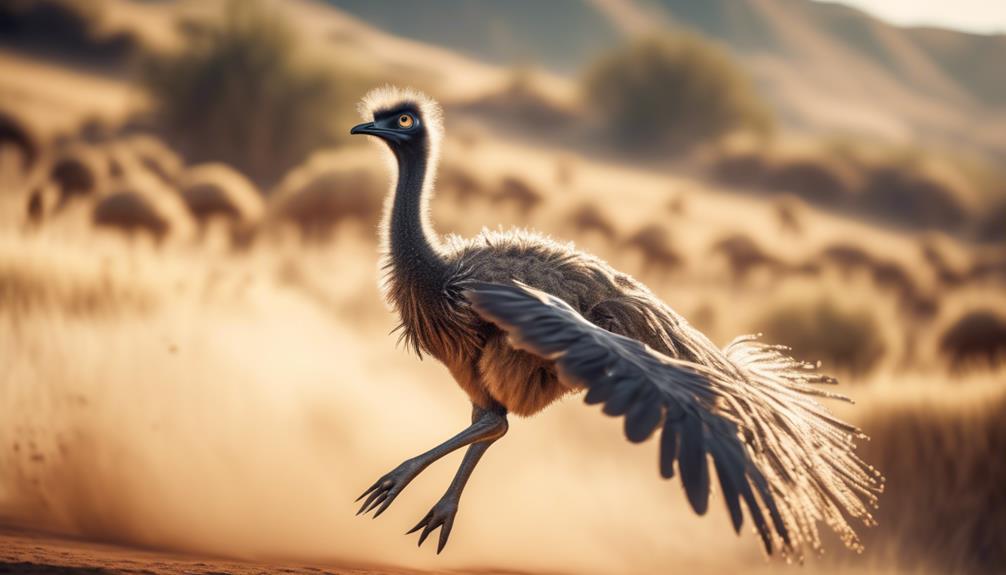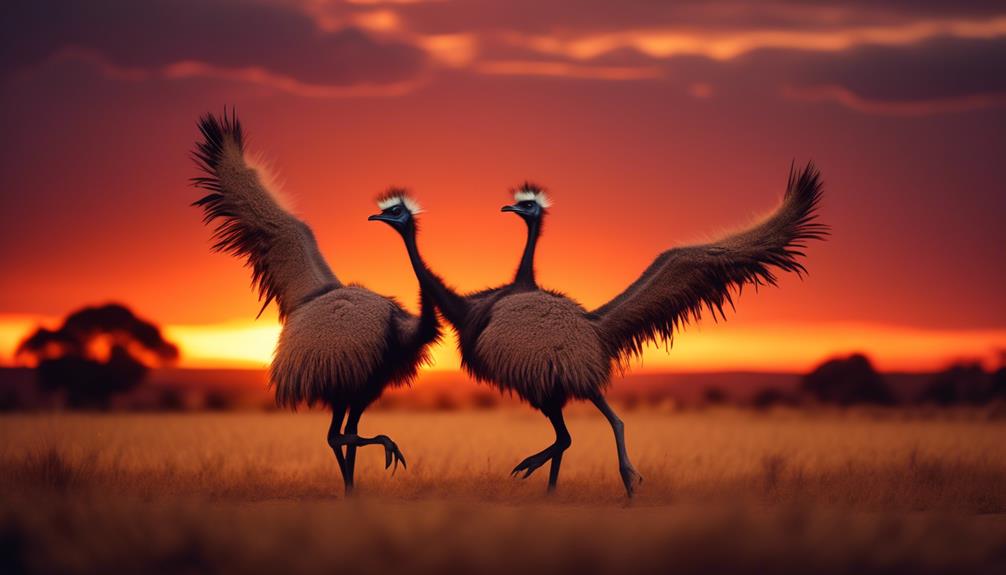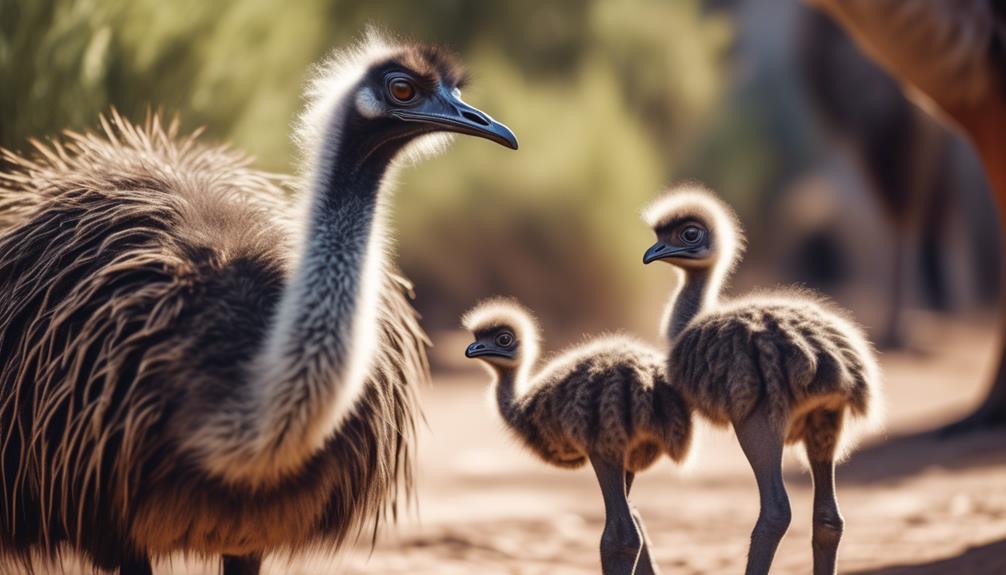
So, you think you know all there is to know about emus? Think again.
These peculiar birds have some truly unique behaviors that might just surprise you. From their head bobbing to their feather fluffing, emus have a whole range of intriguing actions that hold hidden meanings.
But what do these behaviors really signify? Join us on a journey as we explore the fascinating world of emu behaviors and uncover the secrets they hold.
Get ready to see these flightless birds in a whole new light.
Key Takeaways
- Emus communicate through various behaviors such as head bobbing, feather fluffing, wing spreading, and vocalizations.
- Aggressive displays in emus involve puffing up feathers, raising wings, emitting low-frequency sounds, and using distinct postures.
- Understanding aggression triggers is crucial for handling emus safely.
- Emus use different postures and vocalizations to establish dominance and communicate intentions during aggressive encounters.
Head Bobbing
Emus engage in head bobbing behavior, which serves as a form of communication and has various meanings within their social interactions. This unique body language is a fascinating aspect of their behavior that allows them to convey information and establish social hierarchies.
The head bobbing behavior of emus is a complex form of communication signals that can be observed in different contexts. During courtship, male emus engage in rapid head bobbing to attract females. This movement is accompanied by vocalizations, such as low drumming sounds, which further enhance their display. The rhythmic nature of the head bobbing conveys a sense of confidence and dominance, appealing to potential mates.
In addition to courtship, emus also use head bobbing to establish dominance within their social groups. When two emus encounter each other, they may engage in a head bobbing contest, where they rapidly move their heads up and down. This behavior serves as a non-aggressive way to assert dominance without physical confrontation.
It is important to note that the meaning of head bobbing can vary depending on the context and individuals involved. Emus are highly intelligent creatures that rely on body language to communicate their intentions and emotions. By studying their head bobbing behavior, scientists can gain valuable insights into the social dynamics and communication patterns of these fascinating birds.
Feather Fluffing
Feather fluffing, a common behavior observed in emus, serves a variety of purposes and can provide valuable insights into their physical and emotional well-being. This behavior involves an emu rapidly shaking its feathers, causing them to fluff up and settle back into place.
Here are some key points to understand about feather fluffing in emus:
- Social grooming: Emus engage in feather fluffing as a form of social bonding. They often do this behavior with other emus, using it as a means of establishing and maintaining social connections within their group. Feather fluffing allows them to engage in physical contact and establish a sense of unity.
- Preening techniques: Feather fluffing also serves as a way for emus to maintain their feathers' health and appearance. During this behavior, emus will use their beaks to pick at their feathers, removing any dirt, debris, or parasites. This preening process helps to keep their feathers clean, smooth, and in optimal condition.
- Emotional well-being: Feather fluffing can also be an indicator of an emu's emotional state. When they're feeling content and relaxed, emus may engage in feather fluffing as a form of self-soothing. This behavior helps them release tension and promote a sense of calmness.
- Physiological benefits: Feather fluffing aids in regulating an emu's body temperature. By fluffing their feathers, emus can create air pockets, which act as insulation and help to keep them warm in colder temperatures. Conversely, in hotter climates, feather fluffing can help to dissipate excess heat and keep the emu cool.
Wing Spreading

During wing spreading, emus extend their wings horizontally from their body, revealing the intricate patterns and structure of their feathers. This behavior is often observed during social interactions among emus, serving as a visual display of dominance and territoriality. The emu's wing flapping and spreading can be quite mesmerizing to witness, as it accentuates the bird's impressive size and strength.
When an emu engages in wing spreading, it's showcasing its physical capabilities to other emus in the vicinity. By extending its wings, the emu isn't only displaying its feathers but also revealing the length and breadth of its wingspan, which can reach up to 6 feet. This visual spectacle is accompanied by the rhythmic flapping of the wings, which creates a powerful sound that reverberates through the air.
The purpose of wing spreading goes beyond mere aesthetic appeal. It serves as a form of communication among emus, conveying important messages about dominance and territorial boundaries. Emus are known to use this behavior to establish their authority and assert their presence in a given area. By displaying their wings and engaging in wing flapping, emus are essentially saying, 'This is my territory, and I'm in charge here.'
Vocalizations
One can observe the emu's vocalizations as a key aspect of their communication repertoire. These vocalizations serve as a means for the emus to express their emotions and communicate with others in their group. Emu vocalizations aren't only a form of communication but also a defense mechanism.
- Emu calls: These calls are loud and distinct, ranging from deep booming sounds to high-pitched cries. Emus use these calls to communicate with other members of their group, signaling their location or expressing their emotions.
- Drumming: Emus produce a drumming sound by vibrating their throat while inhaling and exhaling. This rhythmic sound is often associated with courtship displays and is believed to attract potential mates.
- Grunts and growls: Emus emit grunts and growls, especially during territorial disputes or when feeling threatened. These vocalizations serve as warnings to other emus to stay away or as a means to establish dominance.
- Alarm calls: When emus sense danger, they emit a loud, piercing call that alerts other members of their group. This vocalization acts as a defense mechanism, allowing the emus to communicate and coordinate their response to potential threats.
Mating Rituals

As we shift our focus to the subtopic of mating rituals, an intriguing aspect of emu behavior comes into view. Emus, like many other bird species, engage in elaborate courtship dances as part of their reproductive strategies. These dances are not only mesmerizing to watch but also serve a vital purpose in the emu world.
During courtship dances, male emus showcase their strength, agility, and overall fitness to attract a mate. They perform a series of impressive displays, including puffing up their feathers, extending their necks, and making deep booming sounds that resonate through the air. These displays are meant to impress the females and demonstrate the male's suitability as a partner.
To give you a better understanding of the courtship dances, here is a table showcasing some of the distinctive moves and their meanings:
| Courtship Moves | Meaning |
|---|---|
| Puffing up feathers | Confidence |
| Extending neck | Dominance |
| Booming sounds | Virility |
| Circular movements | Courtship intent |
Through these courtship dances, emus communicate their intentions and assess potential mates. It is a captivating sight to witness these magnificent birds engage in such intricate displays of affection and desire. The dances play a crucial role in ensuring successful reproduction among emus, fostering intimacy and creating a bond between mates.
Aggressive Displays
Emu aggressive displays reveal fascinating insights into their social dynamics and territorial behavior. These behaviors serve as a means of communication and play a crucial role in maintaining boundaries and asserting dominance within their habitat.
Here are some key aspects of emu aggressive displays:
- Territory defense: Emus are fiercely protective of their territories and will engage in aggressive displays to ward off intruders. They'll puff up their feathers, raise their wings, and emit low-frequency booming sounds to intimidate trespassers.
- Aggression triggers: Emus are triggered by various stimuli that threaten their territory or challenge their authority. These triggers can include the presence of other emus, unfamiliar objects, loud noises, or sudden movements. It's important to be aware of these triggers to avoid provoking aggressive responses from emus.
- Posturing: During aggressive displays, emus exhibit distinct postures to establish dominance. They may stretch their necks, lower their bodies, or lean forward menacingly. These postures serve as visual signals to communicate their intentions and assert their dominance.
- Vocalizations: Emus are known for their deep, rumbling calls, which they use during aggressive displays. These vocalizations serve as a warning to potential threats, intimidating them through their sheer volume and intensity.
Parental Care

During the period of parental care, emus exhibit a range of behaviors that contribute to the survival and well-being of their offspring. One important aspect of parental care is nest building. Female emus take the responsibility of constructing the nest, which is a shallow depression in the ground. They use their strong legs and feet to scrape away the top layer of soil, creating a comfortable and safe place for their eggs. The nest is usually lined with leaves, grass, and twigs to provide insulation and camouflage.
Once the nest is ready, the female emu lays her eggs, typically between 8 and 12, and begins the process of incubation. Incubation behavior is crucial for the development of the eggs. During this period, the female emu sits on the nest, covering the eggs with her body to keep them warm and protect them from predators. She remains dedicated, rarely leaving the nest and only doing so for short periods to feed.
The incubation period for emu eggs lasts around 50 to 55 days, during which the male emu plays an important role in guarding the nest. He defends the nest from potential threats, such as other animals or humans, using his size and intimidating posture.
Frequently Asked Questions
Do Emus Engage in Any Other Behaviors Besides the Ones Mentioned in the Article?
Emus engage in various behaviors beyond those mentioned. For instance, their sleeping patterns are fascinating, with long periods of rest during the day. Additionally, they communicate through a range of signals, including drumming sounds and body movements.
How Long Do Emus Typically Engage in Head Bobbing During Their Mating Rituals?
During emu courtship, you may wonder how long they engage in head bobbing. Factors like age, experience, and competition influence the duration. Let's explore the intriguing world of emu courtship.
Are There Any Differences in Vocalizations Between Male and Female Emus?
Do male and female emus have distinct calls? Emu vocalizations play a crucial role in their communication. By analyzing their unique vocalizations, researchers can identify differences between male and female emus.
Do Emus Display Any Unique Behaviors During Their Parental Care?
During parental care, emus display unique behaviors and strategies. They exhibit aggression and dominance, which helps in understanding their social dynamics. One interesting statistic is that male emus are the ones who incubate the eggs.
Are There Any Specific Aggressive Displays That Emus Use to Establish Dominance Within Their Social Groups?
Emus display unique behaviors, including aggressive displays, to establish dominance within their social groups. These dominance displays can involve puffing up their feathers, hissing, and even charging at other emus.
Conclusion
In conclusion, the emu is a fascinating creature with a repertoire of unique behaviors. From the mesmerizing head bobbing to the majestic wing spreading, each action holds a hidden meaning.
By fluffing their feathers and emitting vocalizations, emus communicate their emotions and intentions. The intricate mating rituals and aggressive displays showcase their prowess and desire for dominance.
Lastly, their exceptional parental care highlights their devotion to their offspring. The emu truly is a marvel of the animal kingdom, a living testament to nature's wonders.





